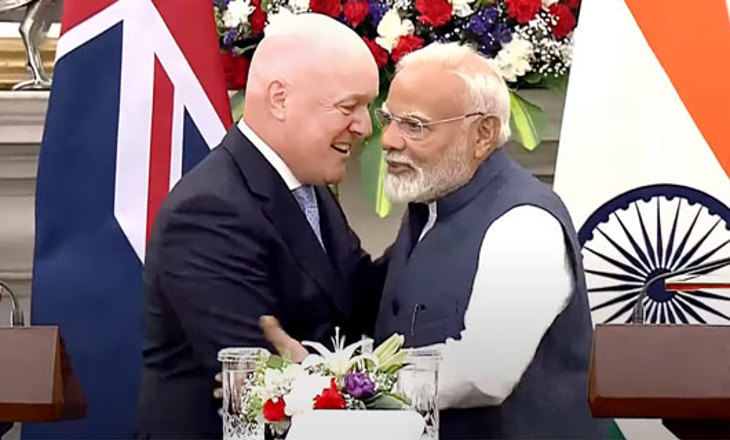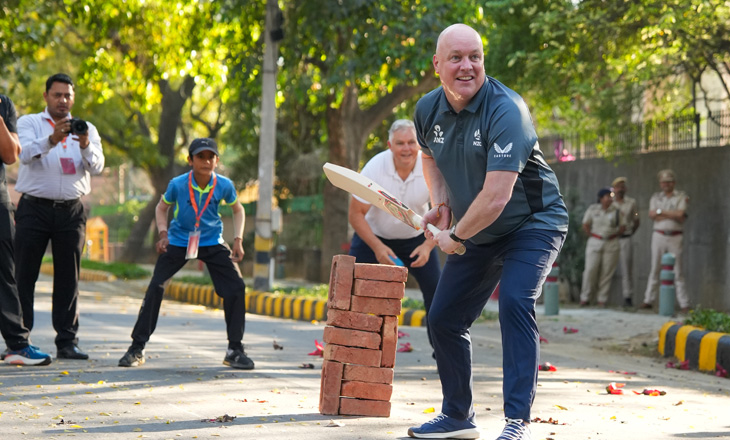Cricket, connection and collaboration: NZ-India Mission 2025
Cricket, connection and collaboration: NZ-India Mission 2025

Much like a Monday morning chat around the office water cooler, New Zealand’s diplomatic mission to India began with Prime Ministers Christopher Luxon and Narendra Modi casually talking sport.
That was no accident.
Sport was front-and-centre of the March 2025 mission, which aimed to strengthen existing bonds and open new doors for collaboration between the 2 nations.
“Sport is very much an international language, so chatting about sport is a great way of beginning a conversation and getting to know someone,” says Government’s Head of Sport Diplomacy Peter Miskimmin.
“It is one of those environments that creates emotion, passion and pride but at the same time you can stand with your competitor and enjoy the experience. It’s a great way of bringing people together.”
Prime Minister Luxon travelled to India with 3 ministers, along with senior leaders from top New Zealand export companies and the New Zealand Indian community.
Black Caps stars Ross Taylor and Ajaz Patel were the prominent faces of the delegation, highlighting the importance of cricket to the New Zealand-India relationship. Their involvement helped draw attention to the visit and its goal of building a long-term partnership with India. The delegation of over 100 politicians, business and community leaders was a deliberate show of commitment.
“The purpose of the mission was to demonstrate that we care, so we turned up en masse,” says Miskimmin, a former New Zealand international hockey player and Olympian.
This spirit was also on display when Prime Minister Luxon played a game of street cricket with local children in Delhi, showing New Zealand’s willingness to connect through a shared love of cricket.

The mission kicked plenty of goals, with 33 agreements signed across the education, technology, tourism, horticulture, aviation and sport sector. But more importantly, it laid the groundwork for closer sporting and economic ties between the countries.
“Sport diplomacy is a tool that can help get the right people in a room so you can build relationships and then advance more formal dialogue around trade, exports, foreign investment and tourism,” says Miskimmin.
That’s exactly what happened in India. Taylor and Patel’s involvement in official events helped attract attention, connect with communities and support wider diplomatic goals.
One example was a cricket leadership and business networking event held in Mumbai for over 300 guests, where the Black Caps stars were the main drawcards. The event gave New Zealand businesses a chance to host customers and suppliers, and also attracted Indian companies interested in working with New Zealand.
For Ajaz Patel, stepping from the cricket field into the world of international diplomacy was an experience that offered a new perspective.
“It opened my eyes as to the part politics plays in sport and vice versa – and how much effort is put in in the background to make things happen for New Zealand.”
“I quickly found that once I was there, the profile of cricket in India meant I stood out and people recognised me off the bat. That makes it a lot easier to connect to people and have those open conversations, those ice breakers that lead on to other more formal conversations.
“I think me being of Indian heritage was an added bonus as well. I understand the cultural differences between the Indian communities. Especially in business [in India], where the connection and alignment come first before the business.”
The business side of the mission, led by Air New Zealand chair Dame Therese Walsh, benefited hugely from the presence of the cricketing stars.
“We had Ross Taylor on the business delegation and his presence was incredible. He was being asked for autographs every five seconds. Him sharing his thoughts and stories about being a New Zealander working in different countries was really powerful.”
Dame Walsh says sport has long played a pivotal role in international engagement, and the mission to India was no exception.
“Most of the missions we have been on have included a sporting component. Everyone wants to know about the All Blacks when you go away. It’s always an element that brings the culture to life and is something that can be shared in many countries.”
The New Zealand Government’s new Sport Diplomacy Strategy amplifies the ability for sport to open doors and build international relationships, Dame Walsh says.
“[The sport component] is quite important so formalising it in the way we have with this new strategy is an excellent way of doing it.”
A major outcome on the sport side of the visit was a new cooperation agreement between Sport New Zealand Ihi Aotearoa and India’s Ministry of Youth Affairs and Sports – the first since 2016, and a key step toward deepening bilateral sporting ties.
This new agreement sets out how we’ll work together in the future, including more games between New Zealand and Indian teams, access to high performance sport facilities, sharing knowledge on participation-focused programmes, and exchange visits for officials, coaches, athletes, administrators and policy experts.
Alongside the government-level agreement, several national sports organisations also signed or discussed their own agreements. These aim to build closer ties and create more regular competition in sports including cricket, hockey, bowls, rugby and football.
The results of these agreements will start to show in 2026, which has been set as a ‘Year of Sporting Unity’ celebrating 100 years of sporting ties between New Zealand and India.
From friendly chats to formal agreements, sport proved to be a powerful connector – opening doors, building relationships, and setting the stage for closer collaboration between New Zealand and India in the years to come.
